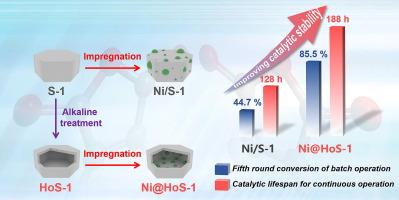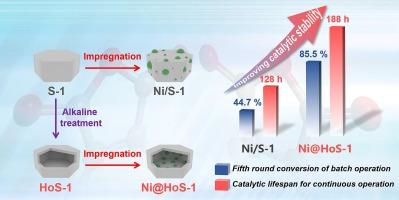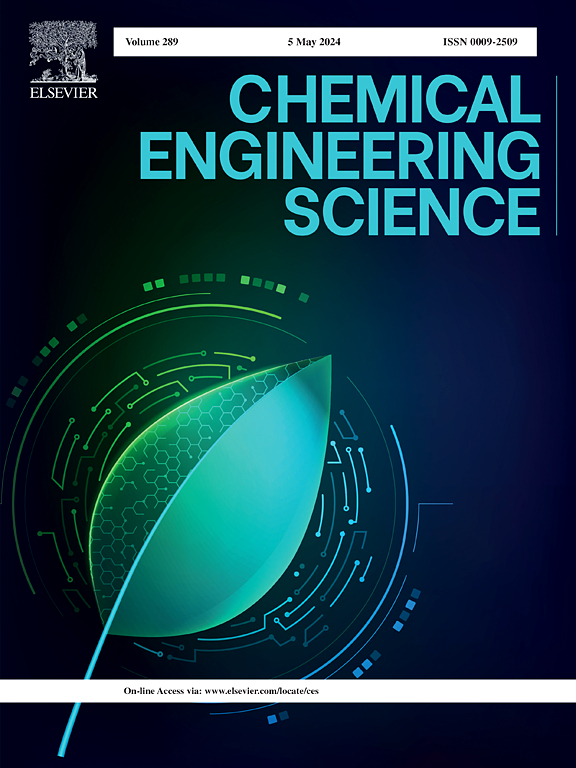在顺丁烯二酸酐氢化过程中作为高稳定性催化剂的中空硅铝酸盐-1 包封镍纳米粒子
IF 4.1
2区 工程技术
Q2 ENGINEERING, CHEMICAL
引用次数: 0
摘要
将活性金属颗粒锚定在沸石笼中可显著提高催化稳定性。本研究采用浸渍法制备了空心硅胶-1(HoS-1)包封镍纳米颗粒催化剂(Ni@HoS-1),并将其应用于 MA 加氢反应。其封装机理被解释为沸石壁限制了 HoS-1 中水分的蒸发,因此镍颗粒在干燥和煅烧后会自发地富集在沸石笼内。实验结果表明,这种特殊设计的结构能有效保护镍颗粒不被浸出,在液相间歇反应中循环 5 次后,Ni@HoS-1 的最终 MA 转化率比 Ni/S-1 高 40.8%(85.5% 对 44.7%)。此外,Ni@HoS-1 的低酸度也延缓了碳沉积的积累,使连续反应寿命从 Ni/S-1 的 128 小时延长到 188 小时。这些发现为活性金属位点在支撑物上的可控定位提供了新的视角。本文章由计算机程序翻译,如有差异,请以英文原文为准。


Hollow silicalite-1 encapsulated nickel nanoparticles as highly stable catalysts in maleic anhydride hydrogenation
Anchoring active metal particles in zeolite cages can significantly improve catalytic stability. In this study, hollow silicalite-1 (HoS-1) encapsulated Ni nanoparticles catalyst (Ni@HoS-1) was prepared using the impregnation method and applied in MA hydrogenation. The encapsulation mechanism was explained as the zeolite wall restricting the evaporation of water in HoS-1, hence Ni particles would be spontaneously enriched within the zeolite cage after drying and calcination. Experiments revealed the specially designed structure effectively protected Ni particles from leaching, and after 5 cycles in liquid-phase batch reactions, the final MA conversion of Ni@HoS-1 is 40.8 % higher than that of Ni/S-1 (85.5 % vs 44.7 %). Moreover, the low acidity of Ni@HoS-1 also delayed the accumulation of carbon deposits, extending the continuous reaction lifespan from 128 h of Ni/S-1 to 188 h. These findings provided a new perspective for the controllable locating of active metal sites against the supports.
求助全文
通过发布文献求助,成功后即可免费获取论文全文。
去求助
来源期刊

Chemical Engineering Science
工程技术-工程:化工
CiteScore
7.50
自引率
8.50%
发文量
1025
审稿时长
50 days
期刊介绍:
Chemical engineering enables the transformation of natural resources and energy into useful products for society. It draws on and applies natural sciences, mathematics and economics, and has developed fundamental engineering science that underpins the discipline.
Chemical Engineering Science (CES) has been publishing papers on the fundamentals of chemical engineering since 1951. CES is the platform where the most significant advances in the discipline have ever since been published. Chemical Engineering Science has accompanied and sustained chemical engineering through its development into the vibrant and broad scientific discipline it is today.
 求助内容:
求助内容: 应助结果提醒方式:
应助结果提醒方式:


